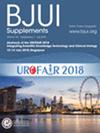Feasibility of randomisation to radical prostatectomy or standard care in patients with metastatic prostate cancer.
IF 4.4
2区 医学
Q1 UROLOGY & NEPHROLOGY
引用次数: 0
Abstract
OBJECTIVE To evaluate the feasibility of randomising patients with newly diagnosed metastatic prostate cancer (mPCa) to cytoreductive radical prostatectomy (cRP) plus systemic standard of care (SOC) vs SOC alone in Belgian centres. PATIENTS AND METHODS This is a phase II, multicentre, prospective, randomised, open-label feasibility trial. Patients with newly diagnosed mPCa were screened across six centres from August 2018 to August 2024. The aim was to randomise 86 patients to either cRP with pelvic lymphadenectomy plus systemic SOC or SOC alone (including radiotherapy in low-volume disease). Eligible patients had an Eastern Cooperative Oncology Group Performance Status of 0-1 and were considered suitable candidates for local treatment. The primary endpoint was the feasibility of randomisation, assessed by the randomisation rate (randomised/eligible). RESULTS A total of 325 patients with newly diagnosed mPCa were screened, of whom 170 (52%) were eligible. The main reasons for ineligibility included unresectable tumours (42% [65/155]) and inadequate surgical fitness (37% [58/155]). Among eligible patients, 75% were excluded (127/170), mostly due to patient refusal (68% [86/127]) and inclusion in competing studies (21% [27/127]). A total of 43 patients were randomised: 21 to cRP and 22 to SOC, yielding a randomisation rate of 25% (43/170). Randomisation rates were lower than anticipated, limiting feasibility in the present trial setting. CONCLUSION Randomising men with newly diagnosed mPCa to RP plus SOC vs SOC alone proved challenging in this Belgian trial. Major barriers to recruitment included limited surgical eligibility and patient refusal. Targeted recruitment strategies or alternative trial designs should be considered.转移性前列腺癌患者根治性前列腺切除术或标准治疗随机化的可行性。
目的:评估比利时中心将新诊断的转移性前列腺癌(mPCa)患者随机分组接受细胞减少性根治性前列腺切除术(cRP)加系统性标准治疗(SOC)与单独接受SOC治疗的可行性。患者和方法:这是一项II期、多中心、前瞻性、随机、开放标签的可行性试验。2018年8月至2024年8月,在六个中心对新诊断的mPCa患者进行了筛查。该研究的目的是随机选择86名患者,接受cRP +盆腔淋巴结切除术加全身SOC或单独SOC(包括小体积疾病的放疗)。符合条件的患者在东部肿瘤合作组的表现状态为0-1,被认为适合局部治疗。主要终点是随机化的可行性,通过随机化率(随机化/合格)进行评估。结果共筛查325例新诊断mPCa患者,其中170例(52%)符合条件。不合格的主要原因包括无法切除的肿瘤(42%[65/155])和手术适应性不足(37%[58/155])。在符合条件的患者中,75%(127/170)被排除,主要是由于患者拒绝(68%[86/127])和纳入竞争研究(21%[27/127])。共有43名患者被随机分配:21名患者接受cRP治疗,22名患者接受SOC治疗,随机化率为25%(43/170)。随机化率低于预期,限制了当前试验设置的可行性。结论:在比利时的这项试验中,将新诊断的mPCa男性随机分配到RP + SOC vs单独SOC证明是具有挑战性的。招募的主要障碍包括手术资格有限和患者拒绝。应考虑有针对性的招募策略或替代试验设计。
本文章由计算机程序翻译,如有差异,请以英文原文为准。
求助全文
约1分钟内获得全文
求助全文
来源期刊

BJU International
医学-泌尿学与肾脏学
CiteScore
9.10
自引率
4.40%
发文量
262
审稿时长
1 months
期刊介绍:
BJUI is one of the most highly respected medical journals in the world, with a truly international range of published papers and appeal. Every issue gives invaluable practical information in the form of original articles, reviews, comments, surgical education articles, and translational science articles in the field of urology. BJUI employs topical sections, and is in full colour, making it easier to browse or search for something specific.
 求助内容:
求助内容: 应助结果提醒方式:
应助结果提醒方式:


